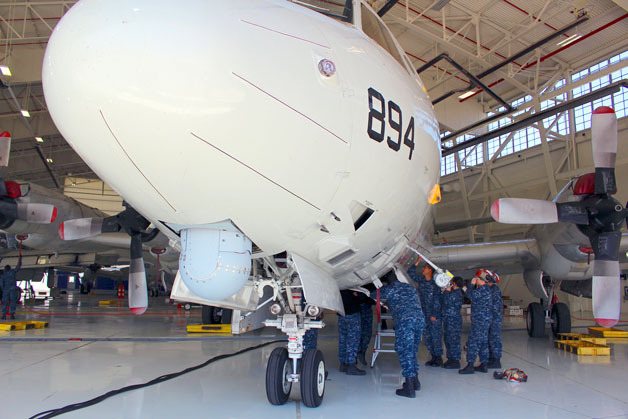Naval Air Station Whidbey Island is preparing to become the primary home on the West Coast for the Navy’s newest maritime patrol aircraft, the P-8A Poseidon.
The federal government is spending millions of dollars on construction on base as well as moving three P-3C Orion squadrons from Hawaii to Whidbey, consolidating operations with the four P-3 squadrons and one EP-3E squadron here.
Already, personnel from Hawaii and their families are arriving on Whidbey, and more are expected to arrive in the fall.
The Navy also is in the midst of transitioning from the aging P-3 turboprop to the P-8, a military version of the Boeing 737-800 built for sub-hunting, surveillance and surface ship attack.
NAS WHIDBEY is perhaps better known for being the home of the Navy’s tactical electronic attack squadrons flying the EA-18G Growler. But the base has a long history of maritime patrol and reconnaissance, stretching back to the PBY-5A Catalina that flew from the Seaplane Base during World War II.
“People aren’t going to look at a P-3 and think it’s as sexy as a Growler,” said Capt. Brett Mietus, a commodore and the commander of Patrol and Reconnaissance Wing Ten at NAS Whidbey.
“We’re more quiet but our mission is no less important to the Navy or our country.”

P-3S AND their replacements are in high demand for surveillance, particularly across the vast expanses of the Pacific and Indian Oceans. They also operate in places like Asia, the Middle East and Europe.
The commodore described his squadrons’ role as like a beat cop, who patrols the oceans constantly to know what’s normal and what’s not.
“If there’s something important going on in the world, someone from this base is probably involved,” he said.
The Navy originally wanted to base three P-8 squadrons at Naval Air Station Kaneohe Bay. Ultimately, officials decided to eliminate the patrol and reconnaissance wing in Hawaii but maintain a P-8 presence with a detachment of two aircraft and rotating personnel.
Consolidating aircraft to Whidbey on the West Coast and Jacksonville, Fla., on the East Coast, is expected to save $300 million.
THAT DECISION is a boon for NAS Whidbey.
On base, workers are putting the finishing touches on a $36 million P-8 training facility that includes state-of-the-art flight simulators that replicate real-life conditions for both the pilot and the rest of the crew. Eventually, P-8 crews will be able to virtually train with crews from other types of aircraft stationed elsewhere.
Workers are busy expanding and modernizing Hangar 6 to accommodate the P-8, which is too tall to fit. The Navy considered building a new $100 million hangar, but remodeling cut that cost in half. Hangar 9, originally used for A-6 Intruders, was already extended to accommodate maintenance on P-3s.
BASE WORKERS also are building a 29,000-square-foot operations center and turning the previous center into a mobile tactical operations center.
The new building will be home to a maritime patrol and reconnaissance wing headquarters. Those projects cost $21 million.
The Navy also plans to build a $30 million MQ-4C Triton control facility on Whidbey. The Triton is the Navy’s high-altitude unmanned aircraft.
A new squadron, VUP-11, is expected to be operational around 2020. Crews will remotely operate two Tritons, which will be maintained of Naval Air Station Point Mugu in California. The Triton will work with the P-8 performing maritime patrol and anti-submarine warfare missions worldwide.
The commodore described the Triton as “eyes in the sky” that can help identify ships in the vast expanse of open ocean.
THE FIRST of the P-8s should begin arriving at NAS Whidbey this fall, Mietus said. It’s a bittersweet transition for many who operate and maintain the P-3. The Navy first began using the P-3 in the 1960s, and there’s some nostalgia for this sturdy workhorse of an aircraft, he said.
Moving from the P-3 to the P-8 is a bit like replacing a classic car with a Tesla, he said.
The P-3 was originally designed as a long-range, anti-submarine patrol aircraft. It’s mission evolved in the last 20 years to include surveillance of the battle space, either at sea or over land.
Its ability to loiter long periods of time proved invaluable during Operation Iraqi Freedom as its crew can view the battlespace and instantaneously provide that information to ground troops, especially U.S. Marines.

BUT TRY outfitting an aircraft built in 1976 with 2016 technology. The commodore said it’s amazing the Navy was able to modify P-3s so well. Ultimately, officials decided it was time for a modern maritime patrol aircraft.
The P-8 requires a smaller crew of nine. It flies higher and faster.
The sleek, open interior is more adaptable to modern technology. Perhaps the biggest change for the crew is the operating system on board, he said.
THE EXPANSION of the wing and transition to the P-8 affect more than the base.
The prospect of more people moving to the area is pushing up real estate prices and prompting Oak Harbor School District officials to come up with solutions for increased enrollment at elementary schools, including adding more portable classrooms.
The commodore estimates that maritime patrol and reconnaissance personnel on base would increase from around 2,000 now to a high of nearly 3,000 in two years. But eventually that number is expected to drop to 2,400 as VQ-1 is disestablished.
USING 2016 as a baseline, the number of total personnel associated with NAS Whidbey is projected to increase by 1,320 people, or 7 percent, to 19,560, by 2018 and by 3,740 people, or 20 percent, to 21,980, by 2019.
Those numbers include Navy personnel, their families, civilian contractors and government employees.
It’s likely more EA-18G Growlers will come, too, though it’s not clear how many Growlers are coming to NAS Whidbey — along with personnel — until the Navy completes an Environmental Impact Statement.


